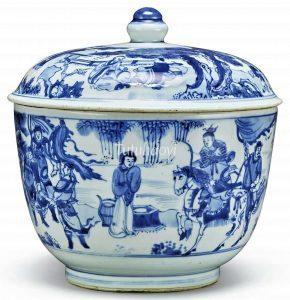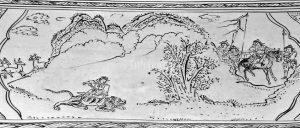Showing Results Containing
The following article is a discussion of the substitution of a mythical beast for a horse as Grand Duke Jiang’s mount on three classic porcelain vases adorned with the same story scene of ‘Bo Yi and Shu Qi Trying to Stop the Mighty Zhou Army’. It ...
Through analysing a famous theme that depicts Bo Yi and Shu Qi Stopping the Zhou Army, Dr Yibin Ni has compared a number of porcelain vessels from Ming and Qing dynasties, and demonstrated his unique insight which can facilitate the correct dating...
This scene was from a popular play ‘The Story of the White Hare’ (Bai Tu Ji 白兔记) and was much admired during the Ming dynasty.
Liu Zhiyuan 刘知远, the hero of the play set during the turbulent Five Dynasties (907–960), became an orphan when he was a teenager. His affluent neighbour looked after him and later...
One day during the Tang dynasty (618-907), Li Keyong (李克用, 856-908), the Prince of Jin (晋王), went out hunting with an entourage of dozens of soldiers, when he encountered a woodcutter in a quiet valley. The woodcutter told Li that The Flying Tiger Hill nearby was an ideal hunting ground. The prince told him that he had d...
There are thirty-six well-known stratagems (三十六计) that the Chinese politicians, strategists, and businessmen have been using for millennia. One of them is the ‘ruse of inflicting pain on oneself or one’s comrades to gain the enemy’s trust’. The scene depicted here is its most famous illustration.
Zhou Yu (周瑜) was ...
When Prefect Mao Bao 毛宝 was stationed in the city of Wuchang 武昌, Hebei province, during the Jin dynasty (晋 265-420), there was a story about a white tortoise who repay...
Bo Yi (or Boyi, 伯夷) and Shu Qi (or Shuqi, 叔齐) were sons of the ruler of Guzhu (孤竹), a vassal state of the Shang dynasty (商朝, 16th-11th cent. BCE). As the king was getting old, he wanted Shu Qi, his youngest son, to inherit his throne. However, when the father died, Shu Qi asked Bo Yi to take over th...






